Self-Storage Unit Climate Control: Maintenance Best Practices for Reliability and Longevity
Introduction: Why Climate Control Maintenance Matters in Self-Storage
Climate control has become a defining feature for many self-storage facilities, providing tenants with peace of mind that their belongings will be protected from extreme temperatures, humidity, and environmental fluctuations. However, simply installing a climate control system isn’t enough—ongoing maintenance is critical to ensure these systems operate efficiently, prevent costly breakdowns, and deliver the level of protection tenants expect. Poorly maintained climate control can lead to equipment failures, increased energy bills, mold or mildew growth, and even property loss. For storage facility owners and managers, understanding the best practices for climate control maintenance is essential not only for protecting assets but also for enhancing tenant satisfaction, maintaining occupancy rates, and maximizing ROI. In this comprehensive guide, we’ll break down expert-recommended procedures, preventative strategies, actionable checklists, and troubleshooting tips to help your climate control systems run reliably for years to come. Whether you’re operating a new facility or looking to upgrade your maintenance protocols, this resource will equip you with the practical knowledge needed to keep your climate-controlled units in top condition.
Understanding Climate Control Systems in Self-Storage Facilities
Key Components of Storage Unit Climate Control
- HVAC Units: The heart of any climate-controlled facility, responsible for heating, cooling, and air circulation.
- Dehumidifiers: Essential in humid regions or facilities storing sensitive items like documents, electronics, or antiques.
- Insulation and Vapor Barriers: Maintain stable interior conditions and reduce system workload.
- Thermostats and Sensors: Allow precise monitoring and control of temperature and humidity levels within each section or unit.
- Ductwork and Ventilation: Distribute conditioned air evenly throughout the facility and remove stale or humid air.
Common Climate Control Challenges in Storage Environments
- Maintaining consistent temperatures across all units, especially in large or multi-story facilities
- Preventing condensation and humidity build-up that can lead to mold, mildew, and corrosion
- Minimizing energy consumption while keeping conditions stable
- Detecting and addressing small issues before they escalate into major failures
Developing a Comprehensive Maintenance Plan
1. Establish Routine Inspection Schedules
Set up regular inspections—ideally monthly for basic checks and quarterly for in-depth assessments. Document each inspection, noting any irregularities, wear, or required repairs. Use digital logs or facility management software for tracking.
2. Prioritize Preventative Maintenance Tasks
- Filter Changes: Replace HVAC filters every 1-3 months, depending on occupancy and local air quality.
- Condensate Drain Line Cleaning: Prevent clogs and leaks by flushing drain lines quarterly.
- Coil Cleaning: Clean evaporator and condenser coils at least twice a year to ensure efficient heat transfer and prevent system strain.
- Thermostat Calibration: Check and recalibrate thermostats and humidity sensors annually to ensure accurate readings.
- Duct Inspection: Check for leaks, blockages, or insulation gaps during each quarterly review.
- Dehumidifier Service: Clean or replace dehumidifier filters and empty reservoirs as recommended by the manufacturer.
3. Maintain Insulation and Building Envelope Integrity
Inspect walls, ceilings, doors, and windows for drafts, moisture intrusion, or physical damage. Repair compromised insulation or vapor barriers immediately to prevent undue strain on the climate control system.
4. Monitor and Document Environmental Conditions
Install data loggers or remote monitoring sensors to track temperature and humidity in real time. Set up alerts for deviations outside the desired range so you can respond before issues escalate.
Monthly and Seasonal Maintenance Checklists
Monthly Maintenance Tasks
- Inspect and clean or replace HVAC air filters
- Check thermostat and sensor functionality
- Verify operation of dehumidifiers (if installed)
- Look for visible signs of condensation or water intrusion inside units
- Listen for unusual system noises during operation
- Record temperature and humidity readings from each zone
Quarterly Maintenance Tasks
- Flush and inspect condensate drain lines
- Clean evaporator and condenser coils
- Inspect ductwork for leaks or obstructions
- Test backup generators or emergency power supplies (if applicable)
- Review and update maintenance logs
Seasonal Considerations
- Spring: Inspect for winter-related damage, recalibrate thermostats, and prepare for increased humidity.
- Summer: Check system cooling performance and monitor for excessive condensation.
- Fall: Prepare for cooler temperatures, switch HVAC settings as needed, and inspect weatherproofing.
- Winter: Ensure heating components are functioning, check for frozen lines, and monitor insulation effectiveness.
Proactive Strategies for System Reliability
Invest in Quality Equipment
Choose commercial-grade HVAC and dehumidification systems designed for continuous operation and heavy-duty use. While initial costs may be higher, these systems are engineered for the demands of self-storage environments and often result in lower long-term maintenance needs.
Implement Zoning for Efficiency
Divide your facility into climate zones based on orientation, building materials, and usage patterns. Zoning enables more precise control, reduces energy waste, and can help you identify trouble spots more quickly.
Train Staff Thoroughly
Ensure your maintenance team is well-versed in the specific requirements of your climate control systems. Provide ongoing training on new technologies, diagnostic tools, and emergency procedures.
Schedule Professional Inspections
Engage licensed HVAC professionals for annual or semiannual system evaluations. These experts can identify subtle issues, conduct refrigerant checks, and verify compliance with local regulations.
Maintain a Spare Parts Inventory
Stock essential replacement parts—such as filters, belts, and fuses—on-site. This allows for immediate repairs and minimizes downtime if a component fails.
Troubleshooting Common Climate Control Issues
1. Uneven Temperatures Across Units
- Check for blocked or leaking ducts
- Inspect insulation and door seals for gaps
- Ensure thermostats are reading correctly and installed away from direct sunlight or drafts
2. Persistent High Humidity
- Verify dehumidifier operation and drainage
- Look for sources of water intrusion (roof leaks, plumbing issues)
- Reassess building envelope integrity
3. Frequent System Cycling or Short Cycling
- Check thermostat placement and settings
- Clean or replace filters
- Have an HVAC professional inspect for refrigerant issues or faulty sensors
4. Rising Energy Costs
- Audit insulation and weatherproofing
- Upgrade to programmable thermostats for better scheduling
- Ensure systems are properly sized for your facility’s needs
Leveraging Technology for Smarter Maintenance
Remote Monitoring and Automated Alerts
Modern climate control systems can be integrated with IoT sensors and facility management platforms. These tools enable real-time monitoring, automated alerts via SMS/email, and detailed trend analysis. Early detection of anomalies can prevent expensive repairs and tenant complaints.
Smart Thermostats and Energy Management
Smart thermostats allow for remote adjustments and scheduling, while advanced analytics can help you identify inefficiencies and optimize system runtime for both tenant comfort and cost savings.
Maintenance Management Software
Digital platforms streamline task scheduling, record-keeping, and inventory management. Detailed maintenance logs support warranty claims and provide valuable data for long-term planning.
Best Practices for Tenant Communication
- Clearly outline the scope of climate control in rental agreements, including temperature and humidity ranges.
- Notify tenants promptly of any scheduled maintenance or system disruptions.
- Encourage tenants to report any signs of condensation, musty odors, or abnormal conditions.
- Educate tenants on proper storage practices to complement climate control (e.g., avoid storing wet items, use plastic bins for documents).
Regulatory Compliance and Documentation
Stay informed about local and national regulations regarding HVAC systems, refrigerant handling, and building codes. Maintain detailed service records, inspection reports, and repair logs to demonstrate compliance and support insurance claims if needed.
When to Upgrade or Replace Climate Control Systems
- Frequent breakdowns or costly repairs that outweigh the value of continued maintenance
- Noticeable decline in system performance or energy efficiency
- Changes in facility usage that require different capacity or control capabilities
- Availability of new technologies that offer significant operational or cost advantages
Conclusion: The Value of Proactive Climate Control Maintenance
Climate control is a key differentiator in today’s self-storage industry, safeguarding tenants’ prized possessions and enhancing your facility’s reputation. But the true value of climate control is only realized through disciplined, proactive maintenance. By adhering to rigorous inspection schedules, prioritizing preventative care, and leveraging modern technology, you can extend system lifespan, reduce unexpected outages, and keep operating costs in check. Equally important is transparent communication with tenants—setting clear expectations and responding swiftly to concerns fosters trust and long-term loyalty.
Investing in the reliability of your climate control systems is an investment in your business’s future. It minimizes risk, maximizes tenant satisfaction, and positions your facility as the preferred choice in a competitive market. Whether you manage a small regional operation or a multi-site portfolio, the steps you take today to maintain your climate control infrastructure will pay dividends in reduced expenses, fewer emergencies, and a steady stream of happy tenants. Don’t wait for the next breakdown—implement these best practices and make climate control maintenance the cornerstone of your facility’s operational excellence.





